How to Scale B2B Paid Media
How we helped an SaaS client scale B2B ad spend and lead volume, and nearly double lead quality
Paid search results had plateaued, and lead quality was decreasing: impressions and clicks were up, but MQLs and sales opportunities were down
Restructure account for efficiency and scaling, focus on turning every dollar of ad spend into revenue-generating leads, manage their accounts with high-touch, detail-oriented customer service
A B2B content-management SaaS provider approached us for help with lead generation. Their paid media marketing results had plateaued, and they wanted to scale up leads while reversing a recent decline in lead quality.
Their agency partner at the time lacked the deep expertise needed for scaling paid search while their in-house team had the necessary knowledge but lacked the bandwidth to execute it. After we took on the client’s paid search efforts, we also collaborated with their in-house team on social advertising and content development.
The company wanted to scale up leads, of course, but they were also concerned about lead quality, which seemed to be on the decline. Paid search impressions, clicks, and ad spend were up, but the volume of leads, marketing-qualified leads (MQLs), and sales opportunities were down, as was revenue per software demo.
Paid Search Audit
The client engagement began with an in-depth audit of their paid search efforts to date. Our team identified the most critical opportunities and presented our plan for implementing them to improve performance.
Our audit is both a granular account examination and a high-level study of strategy, goals, and bottom-line results. Through our years of experience and expertise, we have developed a model of an ideal paid search approach:
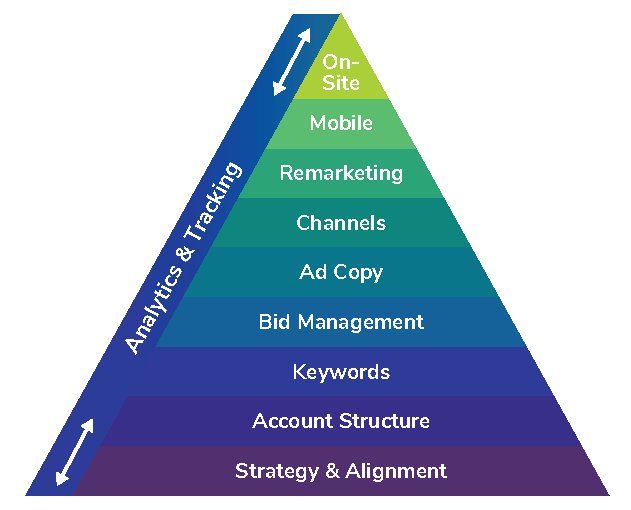
Audit results
We found several fundamental issues, including:
- Lack of strategic account management, hindering performance and driving up costs
- Suboptimal account structure, causing poor performance and impeding ability to scale
- Low ad Quality Scores, further driving up costs and damaging performance—a full 92% of the paid search budget was spent on ads with a Quality Score of 5 or less (out of 10)
Our mission was clear:
- Manage the account with business goals, not just marketing goals, in mind – turn every dollar of ad spend into revenue-generating leads
- Restructure the account to function efficiently and provide a strong foundation for scaling
- Improve the Quality Score of low-quality ads while focusing spend on high-scoring ads
Strategies for improvement
After determining the state of our client’s digital marketing, we created a 3-phase plan for improving it in every possible way:
- Phase 1 would deliver short-term fixes with visible results in less than 1-2 months, such as improving ad copy and adjusting campaign settings
- Phase 2 would focus on account structure and management, including match type and segmentation, in months 3-6
- Phase 3 would expand the reach, power and capacity of the client’s paid search by testing new channels, including remarketing and mobile; this phase is still ongoing because optimization never truly stops
Phase 1: Immediate Fixes
During the first phase of our B2b SaaS Marketing engagement, we used a sort of triage approach: fixing what needed to be fixed to stabilize the account and making simple improvements that yielded significant returns.
Stabilize the account
Ensure correct tracking
The client was tracking paid search ads as an undifferentiated whole in their analytics platform, making it impossible to tell which ads were performing better without going into the account itself. We added tags to every ad for easy analysis in a familiar platform.
Deliver quick results
Ad copy
The client’s existing ad copy template did not allow for optimal ad rendering. It might seem like a minor issue, but it damaged their ads’ click-through ratio and Quality Score. We rewrote their ad templates and copy based on best practices for messaging, content, formatting, and punctuation.
Ad format
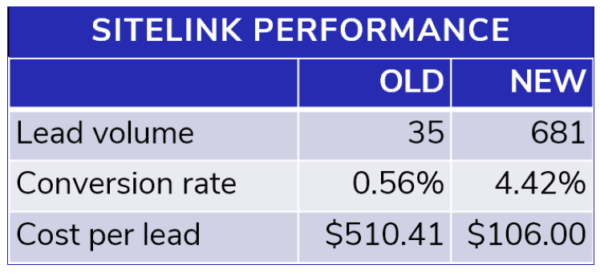 The client wasn’t using sitelink extensions, an option that adds up to four additional links to a paid search ad. For many companies’ ads, these links go to company-centric pages such as “About Us” or their blog; we replaced those with sitelinks targeting the pages and assets searchers were most likely to respond to.
The client wasn’t using sitelink extensions, an option that adds up to four additional links to a paid search ad. For many companies’ ads, these links go to company-centric pages such as “About Us” or their blog; we replaced those with sitelinks targeting the pages and assets searchers were most likely to respond to.
Improving ad copy and building out sitelink extensions to target desired audiences delivered these results in the first few months of our engagement.
Phase 2: Account Rebuild
During Phase 2, we began rebuilding the client’s paid search account using our unique, detail-intensive structure and process. Within 10 weeks, we launched the restructured account and saw immediate improvements in lead volume and cost per lead.
Account rebuild initial issues
In our audit, we had discovered issues with the account structure on every level that were holding the client back from effectively scaling their paid search advertising:
- Campaigns were segmented primarily by product type, rather than product category; performance varied greatly by category, but organizing by product type hid these distinctions
- Match types were mixed in all campaigns; like product categories, match types performed differently and required unique budget and bidding strategies
- Ad groups were broken out by broad product categories, leading to generic ad copy
- The number of ads and keywords per ad group was very inconsistent; several ads and an even distribution of keywords among tightly themed ad groups allows for much more specific testing and adjustment
This lack of segmentation led to incomplete performance data, making productive budget decisions much more difficult. Besides hindering the client’s scaling efforts, this structure resulted in irrelevant ad traffic and wasted ad spend.
Account rebuild strategies
- We completely reorganized the account:
- We broke out campaigns by product categories and match types
- We added significantly more ad groups, each with a specific theme and 5-20 keywords
- We put three ads per ad group for maximum testing efficiency
- Because we now had much clearer data on which campaigns and ad groups were performing well, we could focus spend on high-performing campaigns to deliver higher-quality leads
- We allocated ad spend at the campaign level by match type, based on our “golden ratio” that ensures an optimal mix of traffic with a low cost per lead (CPL)
Account rebuild results
- Average monthly lead volume jumped from 229 to 548
- Cost per lead, which had reached an all-time high before we took over, recovered to its average amount before scaling began
- Average monthly MQL volume more than tripled, going from 98 to 365
- As the quality of leads increased, average monthly cost per marketing lead (CPMQL) dropped by 21%, from $213 to $167
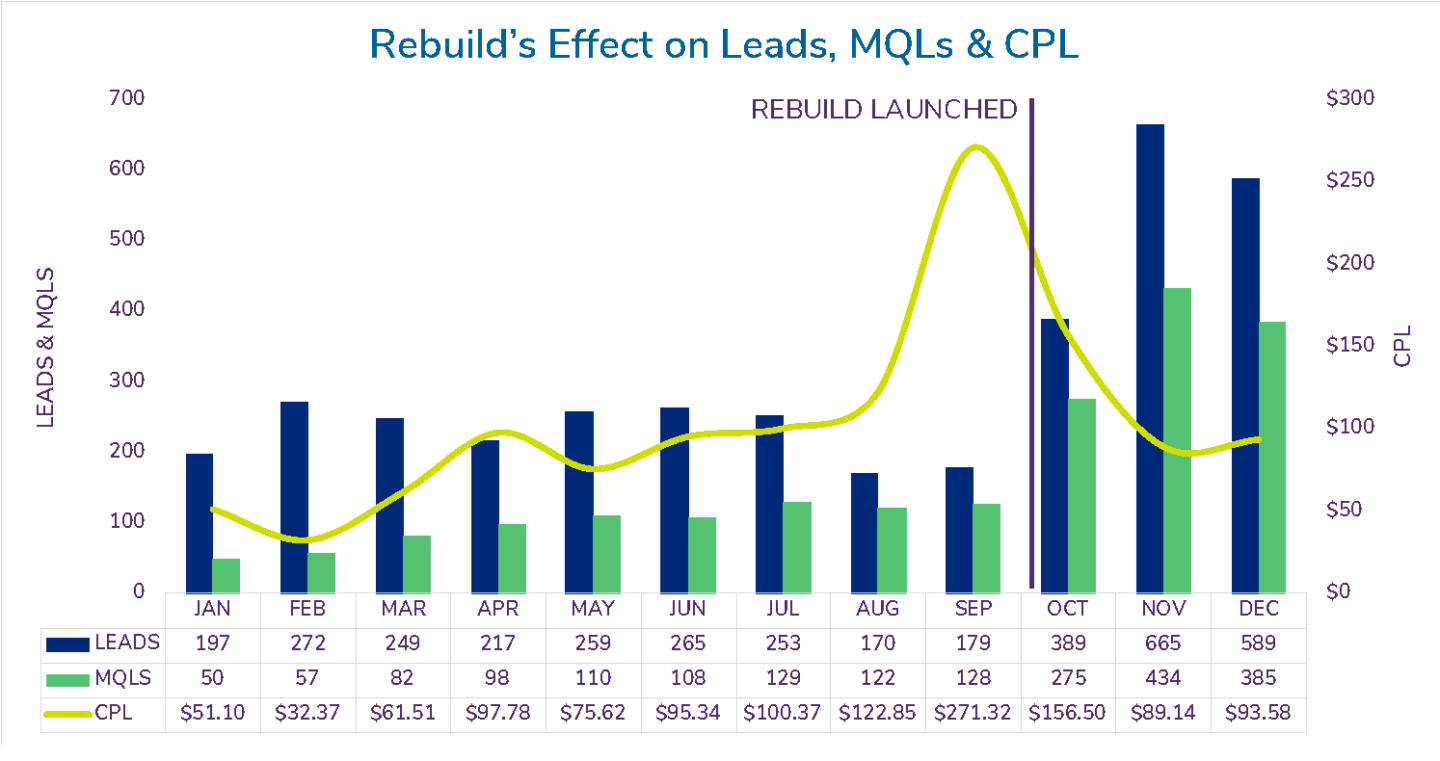
Phase 3: Testing New Channels
The client had tried using Bing for paid search ads, but hadn’t given it a full push due to low bandwidth for the in-house team and lack of expertise from their agency at the time. Thus, lead volume from Bing was relatively low at the start of our engagement, comprising only 2% of the total leads from paid search.
Bing strategies
We greatly increased their efforts in this channel:
- Creating new campaigns
- Expanding keywords
- Adjusting bids to improve ad position and impression share
Bing results
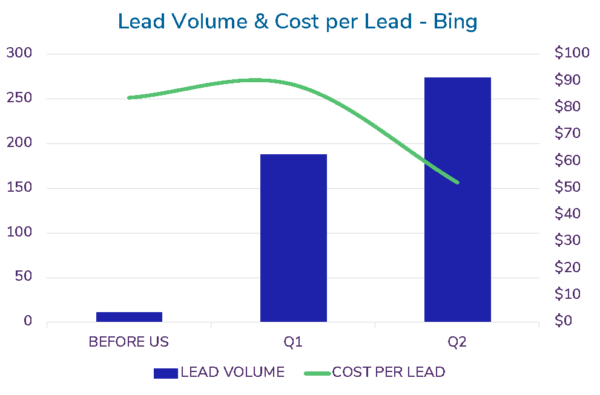 Because we could devote the necessary time and expertise to Bing, we saw results almost immediately. In the first quarter after expanding in Bing:
Because we could devote the necessary time and expertise to Bing, we saw results almost immediately. In the first quarter after expanding in Bing:
- Monthly lead volume went from 11 to 63
- Percentage of lead volume from Bing increased to 6.17%
- Bing’s percentage of total cost was 6.18%, making its CPL almost exactly equal to that of Google
In the next quarter, optimizations to the Bing channel led to even more gains:
- Monthly lead volume increased to 91; percentage of lead volume increased to 7.68%
- Its percentage of cost decreased to 4.8%
- Resulting cost per lead was more than 37% lower than Google’s
Phase 3: Remarketing
As with Bing, our client had made some efforts with remarketing but hadn’t been able to pursue them fully. In the four months prior to our engagement, their remarketing campaigns had generated a total of 20 leads.
Remarketing issues
One of the issues we found was a lack of variety in remarketing messages. For instance, a free cloud product offer was followed by the same offer, usually with the same words and images.
Remarketing strategies
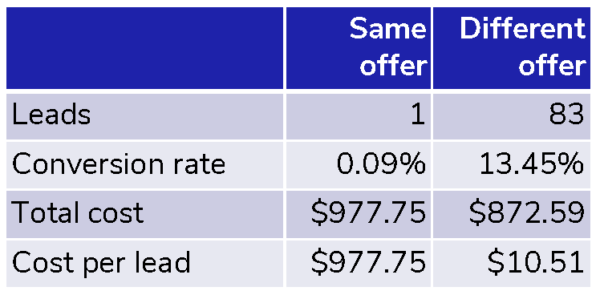 In one example, by simply offering users something different in the second message (a free downloadable guide), we saw an astonishing increase in lead volume and conversion rate, with an equally astonishing 871% reduction in cost per lead.
In one example, by simply offering users something different in the second message (a free downloadable guide), we saw an astonishing increase in lead volume and conversion rate, with an equally astonishing 871% reduction in cost per lead.
We also targeted the second offer based on pages the user had visited, to ensure a strong match between user interest and offer.
We made these further improvements in the client’s remarketing:
- Analyzed campaign performance and tested different offers to maximize low-funnel leads
- Created separate campaigns for similar audiences to allow strategic bidding and budget allocation
- Added text ads to show in more web properties
- Blocked irrelevant placements to save costs
Remarketing results
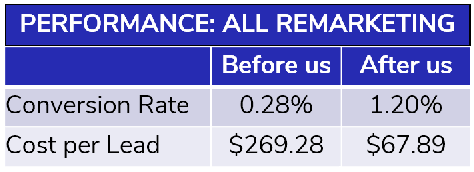 Between Q3 and Q4 of Year 1 (when we expanded the client’s remarketing), total remarketing lead volume went from 18 to 167 – a surge of 828%
Between Q3 and Q4 of Year 1 (when we expanded the client’s remarketing), total remarketing lead volume went from 18 to 167 – a surge of 828%- In that same time, the cost per lead for remarketing decreased by 78%
- By the end of the following year, remarketing quarterly lead volume had grown to 277, an increase of 66% year-over-year from Q4 and an astonishing 1,429% from the start of our expansion
- By that time, remarketing CPL had settled to an amount 53% below its starting point
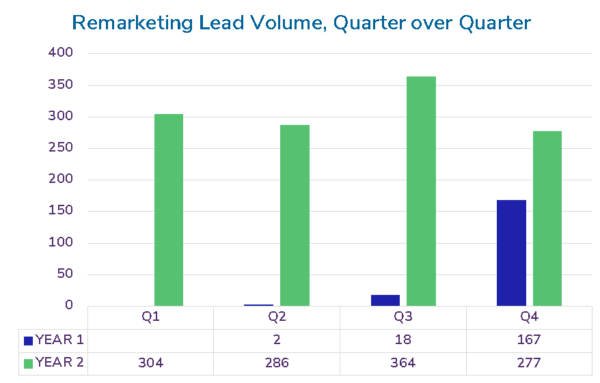
Customer Service as a Strategic Partner
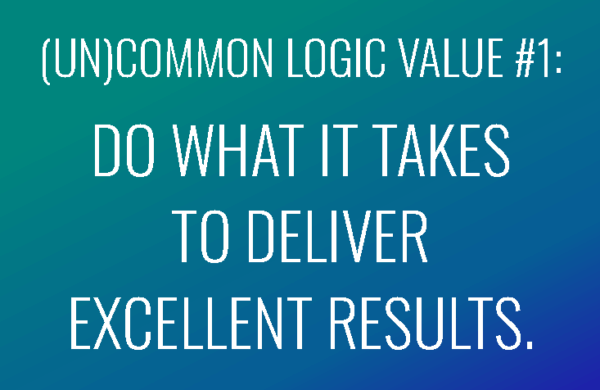 Beyond the results we delivered to our client in paid search, our customer service set us apart, making us a strategic partner for our clients, not just a vendor.
Beyond the results we delivered to our client in paid search, our customer service set us apart, making us a strategic partner for our clients, not just a vendor.
For this client, we’ve provided:
- Industry research about the significant decline in global search traffic for Drupal and the rise of other CMSes to guide future strategy, messages and offers
- A template for a new report in their CRM highlighting paid search insights that can increase MQLs
- Content to present at a conference as a last-minute invite —plus our CEO flew to the conference for additional help and support
We’ve also provided guidance on:
- Landing page improvements to maximize the value of their leads
- Analytics strategy and implementation
- Strategy for LinkedIn advertising and lead generation
- Their content development process, so topic generation is driven by data and performance rather than brainstorming alone
Overall Results
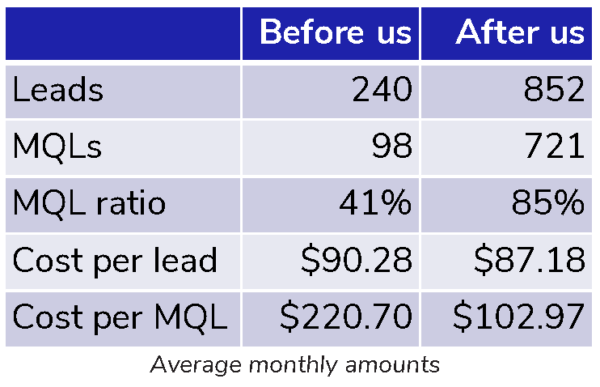 We delivered major increases in lead volume and MQLs that have continued through our engagement with this client. Since we began working with them…
We delivered major increases in lead volume and MQLs that have continued through our engagement with this client. Since we began working with them…
- Average monthly leads have grown by 272%
- Average monthly MQLs are 636% greater
- Lead quality, as measured by the ratio of MQLs to leads, has more than doubled
- Average monthly cost per lead has decreased by 3%, while average monthly cost per MQL has decreased by 53%
When our client approached us, they had “hit the wall” with their paid search efforts. Impressions, clicks, and ad spend were all up, but lead volume, MQL volume, sales opportunities, and revenue per software demo were all down.
We combined our best practices, data-based approach and strategic insight with a focus on generating high-quality leads, and delivered results almost immediately. We have continued that growth, so the client’s paid search is both scalable and sustainable.
Perhaps most importantly, we significantly improved the quality of the client’s leads. Before engaging us, their average monthly ratio of MQLs to leads was 42.79%; we have nearly doubled that number to 84.62%.
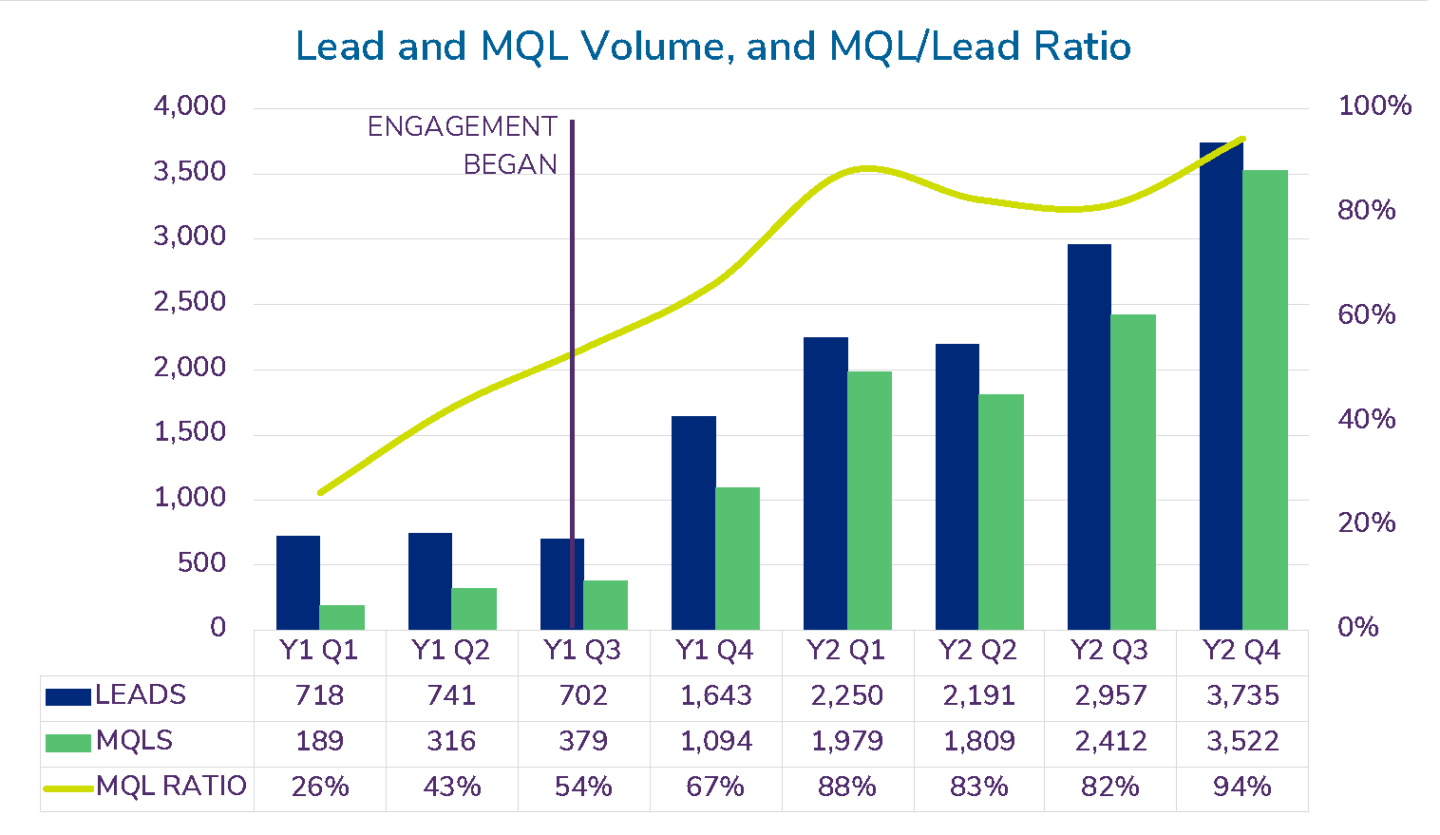
Takeaways
These results didn’t come from throwing more ad spend at the account or plunging into random channels. Instead, they’re a natural development from our philosophy regarding digital marketing.
Build it right, sleep at night
A good paid-search account structure provides a foundation that can support sustainable growth. Our proven account structure allowed us to more than double lead volume and more than triple MQL volume in just one quarter.
Prioritize the performers
Maximize the highest-performing elements first, as they’ll deliver results to the bottom line soonest. Once they’ve reached their highest performance point, start increasing spend on lower-performing elements, while experimenting on how to improve their performance.
Always be testing and optimizing
Never settle for “good enough” or “what worked before.” Keep seeking ways to improve performance, remove friction from the buying process and introduce beneficial innovations.

